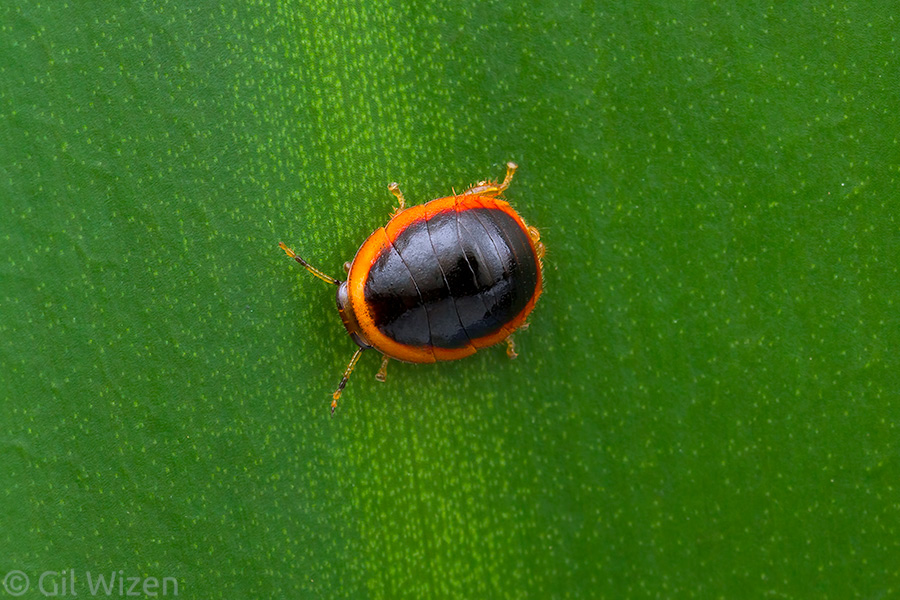From a blattodean to Nilio beetles
This is the story about how a small blattodean taught me something I did not know about beetles.
While photographing frogs in the Ecuadorian Amazon this past October, I noticed a tiny insect running across the surface of a fallen leaf resting on the forest floor. It had bright colors and looked interesting, so I collected it in hopes to photograph it later. When I finally got to do it, I was struck by its deception. You see, when I initially spotted it I thought it was a beetle. The dome-shaped body and the bright coloration resembled those of some leaf beetle species (family Chrysomelidae), and this insect even moved and walked like a beetle. Nevertheless, a close inspection revealed that its whole body was segmented. This was no beetle. It was a blattodean nymph.
Blattodeans exhibit some beautiful examples for mimicry, with some species resembling poisonous fireflies and venomous assassin bugs. It should come as no surprise that a blattodean might benefit from looking like a leaf beetle. While many leaf beetles are harmless, some species harbor chemical compounds that make them poisonous or distasteful to predators. Unfortunately, identifying a blattodean from its larval stage is very tricky and close to impossible. I was not able to locate anything that looked like the adult stage of this species. However, when I examined this cute blattodean I remembered that I have seen this color scheme on a leaf beetle before, and after digging in my old photo archive I was able to find the record.
I took this photo on one of my first visits to Ecuador, over a decade ago. I did not plan to do anything with the photo, but I thought it was a nice-looking leaf beetle and so I snapped a quick photo for my own records. Only I was completely off. This is not a leaf beetle.
Unlike most of its family members that are elongated and dull-colored, Nilio is a genus of darkling beetles (family Tenebrionidae) that bear a striking resemblance to leaf beetles and ladybugs. This resemblance can fool even experienced entomologists. Darkling beetles are well-known for their chemical defense, secreting odorous chemicals that will deter even the most enthusiastic field entomologist. This can explain the blattodean mimicry shown above.
After I realized these photos show a species of Nilio, I checked the rest of my photos from the very same trip, and started finding more photos of Nilio species.
Here is a group of larvae on a branch. Nilio larvae are gregarious (live in groups) and feed on epiphytic lichens. If you have ever seen the typical wire-worm larvae of darkling beetles you will understand why I labeled this photo as “chrysomelid larvae” in my archive.
In some species, not only the larvae, but also the adults, are gregarious. Here is a group of adults I found on a tree trunk close to their pupation spot. Like the larvae, these adults were feeding on lichens as well.
As you can see, not all Nilio species have bright coloration as the species shown above. However, even when they are closer to their “darkling roots” they still look more like to members of Chrysomelidae than Tenebrionidae. This all goes to show that even when you are confident about your knowledge of insect taxonomy or biodiversity, nature can still surprise you. I embrace these moments when I am caught unprepared; nothing like learning something new!










Invertebratedude
What an ADORABLE little roach nymph, looks a lot like this one here: https://www.flickr.com/photos/36494393@N00/26657089714/in/album-72157650992242869/
My personal theory is that they are Paratropes nymphs, but that’s just a hunch.
Love the Nilio sp, it’s so interesting how diverse the Tenebrionidae is! 😀 Also interesting how the roach nymph seems to mimic the Nilio, smart considering that Tenebrionid defense fluids tend to be rather strong!
wizentrop
Thank you for that link! The nymph in the photo is very similar to the one I found, but also different. There are subtle differences in the antennae and body surface that suggest this is either a later instar or a different (yet still related) species. Very cool to see that someone else mistook it for a leaf beetle, it means that I am not alone in this.
I think these nymphs are a bit too small to be Paratropes, they are tiny (~2.5mm) and look quite developed for a first instar. Also the antennae of Paratropes are proportionally much longer. Hard to tell for sure, we might just have to look for it again and see!
invertebratedude
Indeed, they are probably at different stages of development, or more likely a different species, but I’m certain they are at least in the same genus, whatever that may be…
Well now that I know the size of the nymph, it does seem a little far fetched that these could be the offspring of Paratropes, (though not impossible).
Antenna length is not the best way to tell roaches apart, many species have nymphs with short antennae while the adults’ antennae are much longer, like Therea or Blaberus. Still, I would expect the nymphs of Paratropes to have rather long antennae, or at least longer than the little stubs this cutie has, so these are most likely not Paratropes.
Would be very interesting to see what they turn into when mature, hopefully you can find some more nymphs of this species in the future and rear them to adulthood, I’m almost positive they are some sort of Ectobiid, question is what kind? 😀